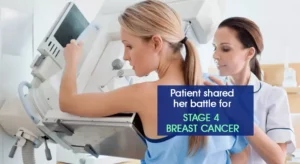Lung cancer is one of the most common and deadly forms of cancer. It is important to be aware of the symptoms, causes, and treatment of lung cancer options available. Symptoms of lung cancer can include a cough that does not go away, shortness of breath, chest pain, weight loss, and fatigue. If you experience any of these symptoms, it is important to see a doctor right away. There are many possible causes of lung cancer, including smoking, exposure to secondhand smoke, radiation exposure, and exposure to certain chemicals. Treatment options vary depending on the stage of cancer and the overall health of the patient. If you or someone you know has been diagnosed with lung cancer, there are many resources available to help you cope with the diagnosis and treatment.
Common Symptoms of Lung Cancer
Lung cancer is a disease that affects the lungs, and it can be difficult to detect in its early stages.
In the treatment of lung cancer, most common symptom of lung cancer is a cough that does not go away, but other symptoms include chest pain, shortness of breath, and wheezing.
If you have any of these symptoms, it is important to see a doctor for a diagnosis.
Causes of Lung Cancer
- The main cause of lung cancer is smoking, but other factors can also play a role. These include exposure to secondhand smoke, air pollution, and asbestos.
- Lung cancer is caused by the uncontrolled growth of cells in the lungs.
- People who have a family history of lung cancer are also at increased risk.
- Treatment of lung cancer usually involves surgery, chemotherapy, and radiation therapy.
Diagnosis of Lung Cancer
– Treatment of Lung cancer is diagnosed using a variety of tests, including a physical exam, imaging tests, and biopsies.
– Imaging tests include chest X-rays, computed tomography (CT) scans, and positron emission tomography (PET) scans. These tests can often show if there is a mass or nodule in the lungs.
– A biopsy is the removal of tissue to be examined under a microscope. A biopsy can be done with a needle or through surgery. The type of biopsy will depend on the size and location of the mass or nodule.
– After lung cancer has been diagnosed, additional tests may be done to stage cancer. Staging is a way of describing how far cancer has spread in the body. The stage of lung cancer helps determine treatment options and helps predict the outlook for survival.
Types of Lung Cancer
There are two main types of treatment of lung cancer: non-small cell lung cancer (NSCLC) and small cell lung cancer (SCLC). NSCLC is the most common type of lung cancer, accounting for about 85% of all cases. SCLC is less common, accounting for about 15% of all cases.
NSCLC can be further divided into four subtypes: squamous cell carcinoma, adenocarcinoma, large cell carcinoma, and bronchioalveolar carcinoma. Squamous cell carcinoma arises from the thin, flat cells lining the airways. Adenocarcinoma arises from the glandular cells that produce mucus. Large cell carcinoma can arise from any type of cell in the lung. Bronchioalveolar carcinoma is a special subtype of adenocarcinoma that is often found in young women.
SCLC is divided into two subtypes: oat cell carcinoma and combined small cell carcinoma. Oat cell carcinomas are so named because they resemble oats under a microscope. Combined small cell carcinomas contain both oat cells and large cells.
Treatment of Lung Cancer
There are two types of lung cancers: non-small cell lung cancer (NSCLC) and small cell lung cancer (SCLC). NSCLC is the most common type of lung cancer, accounting for about 85 percent of all cases. SCLC is less common but more aggressive, and accounts for the remaining 15 percent of cases.
The most common symptom of lung cancer is a cough that does not go away. Other symptoms may include shortness of breath, chest pain, hoarseness, weight loss, and fatigue. If you experience any of these symptoms, it is important to see your doctor right away for a proper diagnosis.
Treatment of lung cancer is usually diagnosed through a combination of imaging tests and a biopsy (tissue sample) taken from the suspicious area. Once diagnosed, treatment options will be determined based on the specific type and stage of lung cancer.
The standard treatment for NSCLC is surgery to remove the tumor followed by chemotherapy or radiation therapy, or both. For SCLC, treatment typically begins with chemotherapy followed by radiation therapy if needed.

Diet of Lung Cancer
There is no specific diet that can prevent or treatment of lung cancer, but eating a healthy diet with plenty of fruits, vegetables, and whole grains may help lower your risk. Some studies have found that people who eat a diet high in antioxidants have a lower risk of lung cancer.
Lung cancer is mainly caused by smoking, but other factors such as air pollution and exposure to certain chemicals can also increase the risk. The best way to reduce the risk of lung cancer is to quit smoking and avoid exposure to secondhand smoke.
Prevention of Lung Cancer
Lung cancer is the leading cause of cancer death in both men and women in the United States. Smoking is by far the most important risk factor for developing lung cancer, accounting for an estimated 80 to 90 percent of all cases. The best way of lung cancer prevention is to avoid smoking or to quit if you already smoke it is the best treatment of lung cancer.
There are many resources available to help you quit smoking, including:
– Your doctor or healthcare provider for treatment of lung cancer
– Smoking cessation classes
– Online resources and support groups
– Nicotine replacement therapies such as patches, gum, or lozenges
– Prescription medications
If you are unable to quit smoking on your own, don’t give up. Talk to your doctor or another healthcare provider about the treatment of lung cancer and other options.
Conclusion
Lung cancer is a devastating disease that takes the lives of too many people every year. However, by understanding the symptoms, causes and treatment options, we can empower ourselves and our loved ones to take action if lung cancer is suspected. If you are experiencing any of the symptoms discussed in this article, please don’t hesitate to speak to your doctor. Early detection is critical for the successful treatment of lung cancer.




